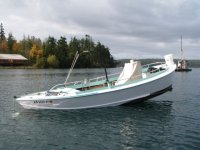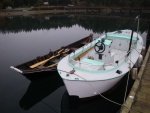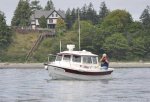thataway wrote:
We did discuss this boat (or class of boats) in 2008. She carries the "V" all of the way aft, and is a displacement boat. Even the Bartenders, had "wings" on on each side about at the chines, to give more planing surface.
The Timber Coast design is a displacement hull, and very different from the Bartender hull. The TC design was commissioned as a displacement craft about 2008, in anticipation of demand for low speed, fuel efficient boats of that length. It carries some of the lines of a Bartender, but below the water, the two differ significantly.
Bartender hulls carry some vee aft, but the dead rise is very slight, maybe an inch rise on each side, over a chord of 30 inches, making a planing surface on which the boat rides at speed. The "wings" are extensions of the spray rail, and are not engaged with the water above planing speed when running straight ahead. They come into play at speed only in a turn. I think they likely assist in making for smoother, more stable turns, but am not knowledgeable enough to tell for sure. The spray rail only meets the upper edge of the chine guard at the very end of the rail.
The transition to plane is so gradual that sometimes when accelerating, i was hard pressed to say exactly when planing began.
The planing surface at speed is very small for the hull area, for any chosen length of Bartender, which is why the design requires care to avoid overbuilding -- unneeded weight can kill the performance. Planing boats with a pointy end aft pretty much all have to deal with that. My 20.5 ft BT came in at 1750 lbs, dry, engine etc installed, which likely accounts for the low fuel consumption, about 2 to 2.4 gallons per hour, on plane, variable conditions. Load it up with 6 people and gear, and the performance goes to hell.



